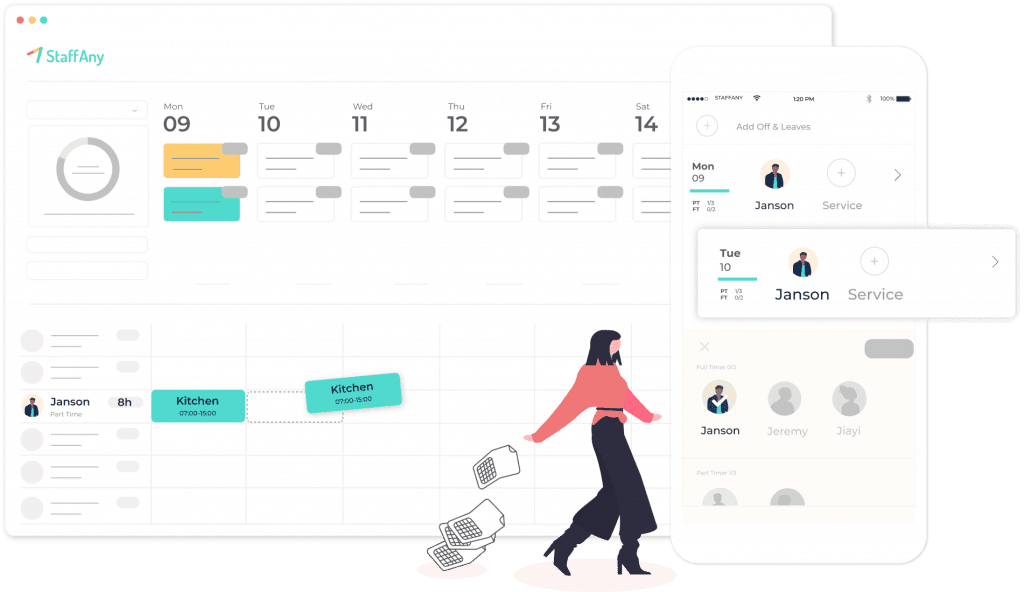The traditional 9-to-5 work schedule is no longer the only norm in today’s fast-paced and interconnected world. Globalisation, technological advancements, and the ever-growing demand for round-the-clock services have given birth to the concept of rotating shifts. This dynamic work schedule has become a staple in industries that require uninterrupted operations. So, how do rotating shifts work?
In this article, we will delve into how do rotating shifts work, the benefits they offer, the various types of rotating shifts, and how businesses can effectively manage them. But first, you must understand what rotating shifts are. Let’s get started!
What is a Rotating Shift?

A rotating shift is a work schedule where employees alternate between different shifts over a designated period, such as a week or a month. This means that an employee might work the morning shift for a few days, then switch to the evening shift and later to the night shift.
The main goal of rotating shifts is to ensure businesses can operate round-the-clock while distributing the workload fairly among their workforce. This approach is particularly common in industries that require continuous operations, such as hospitality, healthcare, manufacturing, transportation, and emergency services.
Read more: 8 Tips for Rotating Shift Effectively
How Do Rotating Shifts Work?
Rotating shifts follow a predetermined pattern, typically involving three or more shifts. The pattern can vary based on the needs of the business and the employees’ preferences. One common rotating shift pattern is the “4-on, 4-off” schedule, where employees work four consecutive days followed by four days off. Another pattern is the “2-2-3” rotation, where employees work two days, have two days off, and then work three days before having another two days off.
The rotation can be clockwise or counterclockwise, meaning employees can move from one shift to the next sequentially. For example, an employee might start on the day shift, move to the evening shift, and finally to the night shift. Alternatively, some businesses use a “weekend warrior” approach, where employees work only on weekends in a rotating manner.
Why Is a Rotating Shift Required?
A rotating shift schedule is required for several reasons, including:
1. Continuous Operations
Many businesses, such as those in manufacturing, healthcare, customer service, and transportation, need to operate around the clock to meet customer demands and provide services at all hours. Rotating shifts ensure that there are employees available to work during different shifts, including nights and weekends.
2. Workload Distribution
In industries with fluctuating workloads or varying demand throughout the day, rotating shifts help distribute the workload more evenly among employees. This can improve efficiency and prevent overburdening workers during peak times.
3. Training and Skill Development
Rotating shifts can be used as a training tool. Employees are exposed to different tasks, roles, or responsibilities during different shifts. This cross-training helps employees develop a broader skill set and adaptability, making them more versatile and valuable to the company.
4. Employee Preferences
Some employees may prefer or require specific shifts due to personal commitments, family needs, or health reasons. Offering rotating shifts allows employers to accommodate various scheduling preferences and needs.
5. Health and Well-being
Continuous night shifts or long-term exposure to a single shift pattern can have adverse effects on employee health and well-being. Rotating shifts can help mitigate these negative impacts by spreading out the burden of working less desirable shifts.
6. Labor Regulations
In some cases, labor laws or union agreements may require or encourage the use of rotating shifts to ensure fairness in scheduling and to provide employees with equal opportunities for different shifts.
In summary, rotating shifts are required to meet operational demands, distribute workload effectively, foster employee development, accommodate employee preferences, promote well-being, and comply with labor regulations.
Rotating shifts come in various patterns and structures, each designed to cater to the unique needs of different industries and employees’ preferences. Understanding these different types of rotating shifts can provide valuable insights into how organisations manage their workforce and maintain operational efficiency. Here are five common types of rotating shifts:
1. Fixed Pattern Rotating Shifts
This type of rotating shift follows a predetermined pattern that employees can anticipate and plan for. For instance, an organisation might establish a fixed pattern such as “week 1: morning shift, week 2: evening shift, week 3: night shift.” This consistency allows employees to adapt to their schedules more effectively and arrange their personal lives around work commitments.
2. Slow Rotating Shifts
Slow-rotating shifts involve longer periods on each shift before transitioning to the next. For example, employees might work the morning shift for a month before moving to the evening shift for the next month. This gradual shift change can give individuals ample time to adjust to new sleep patterns and work routines.
3. Fast Rotating Shifts
In contrast to slow-rotating shifts, fast-rotating shifts have shorter periods on each shift before moving to the next. Employees might work a few days or weeks on one shift before transitioning to another. While this approach allows for quick rotation, it can also be more challenging for individuals to adapt to rapidly changing sleep schedules.
4. Forward Rotating Shifts
Forward-rotating shifts move in sequential order, typically progressing from the day shift to the evening shift and then to the night shift. This alignment with the natural progression of the day can make it easier for employees to adjust to new sleep patterns.
5. Reverse Rotating Shifts
Reverse rotating shifts follow the opposite sequence, with employees moving from the night shift to the evening and day shifts. This type of rotation can be more challenging for the body’s internal clock, as it requires employees to adjust to working during daylight hours after being accustomed to working at night.
What Business or Industry Uses Rotating Shift Schedule?
Several industries and businesses utilize rotating shift schedule to maintain continuous operations or accommodate various scheduling needs. Here are some examples:
1. Manufacturing and Production
Factories and production facilities often operate 24/7, requiring rotating shift to ensure continuous manufacturing processes.
2. Healthcare
Hospitals, clinics, and emergency services use rotating shift to provide round-the-clock patient care. This includes nurses, doctors, and support staff.
3. Emergency Services
Police departments, fire stations, and other emergency services operate on rotating shift to respond to incidents and emergencies at any time of the day or night.
4. Retail
Some retail businesses, especially those operating in busy urban areas or at transportation hubs, may use rotating shift to extend their hours of operation.
5. Transportation
Airlines, public transportation services, and shipping companies require personnel to work rotating shift to cover various flight schedules or transportation needs.
6. Hospitality and Tourism
Hotels, resorts, and restaurants may use rotating shift, especially in departments like front desk, housekeeping, and food service, to meet the demands of guests around the clock.
7. Energy and Utilities
Power plants, water treatment facilities, and other utilities often require rotating shift schedules to maintain uninterrupted service.
8. Security Services
Security personnel in industries such as event security, corporate security, and private security often work in rotating shift to ensure continuous protection.
9. IT and Tech Support
IT support teams may work in rotating shift to provide 24/7 assistance to clients or internal users, especially in global companies with offices in different time zones.
10. Entertainment and Media
Broadcasting, news agencies, and entertainment venues may have staff working rotating shift to cover live events, broadcasts, or productions at various hours.
11. Research and Laboratories
Some research facilities and laboratories, particularly those conducting experiments or experiments that require continuous monitoring, may operate on rotating shift.
12. Mining and Extraction
Industries involved in mining and extraction may operate on rotating shift to ensure continuous production and the safety of workers in challenging environments.
Rotating shift are often necessary in industries where operations need to continue 24/7 or where services must be available at various times to meet customer demand or address emergencies.
Effective Tips for Rotating Shift Schedule in Restaurant
Here are essential tips for managing rotating schedule in a restaurant or food and beverage business:
1. Clear Communication
Communicate shift schedules well in advance and provide a central location for employees to access the latest schedule updates.
2. Fair Rotation
Ensure fairness in assigning shifts, distributing both peak and off-peak hours evenly among the staff.
3. Flexible Scheduling
Implement a flexible scheduling system that allows employees to express preferences and swap shifts when needed.
4. Health and Well-being Support
Pay attention to the health and well-being of employees working rotating shifts, providing resources for stress management and work-life balance.
5. Provide Adequate Breaks
Schedule breaks strategically to allow employees sufficient time to rest and recharge during their shifts.
6. Employee Input
Involve employees in the scheduling process, taking into account their preferences and considering input when creating shift schedules.
7. Recognition and Incentives
Recognize and appreciate employees working less desirable shifts, and consider offering incentives to motivate staff.
8. Regular Check-ins
Conduct regular check-ins with staff working rotating shifts to address concerns and gather feedback on the scheduling system.
9. Emergency Backup Plan
Develop contingency plans for unexpected events, cross-training employees for key roles to handle emergencies.
10. Compliance with Labor Laws
Ensure that the scheduling practices comply with labor laws and regulations regarding working hours, breaks, and overtime.
These essential tips focus on clear communication, fairness, flexibility, employee well-being, and compliance with labor regulations, providing a foundation for effective management of rotating shifts in the restaurant or F&B industry.
Use Employee Scheduling Software to Streamline the Rotating Shift Schedules Process

In a world that never sleeps, the concept of rotating shifts has proven to be an invaluable solution for businesses aiming to maintain seamless operations while prioritising the well-being of their workforce. Understanding how do rotating shifts work is key to ensuring a balanced and efficient work environment. The benefits are undeniable, from continuous operations and reduced fatigue to enhanced flexibility and skill development.
As organisations navigate the complexities of rotating shifts, having the right tools can make all the difference. That’s where StaffAny’s employee schedule maker comes into play. With our auto-scheduling feature, you can effortlessly assign staff to shifts with just a click. Our real-time schedule update feature can inform your team about changes, automatically updating their schedules and identifying conflicts. Contact us today to discover how StaffAny can revolutionise rotating shifts for your organisation!













